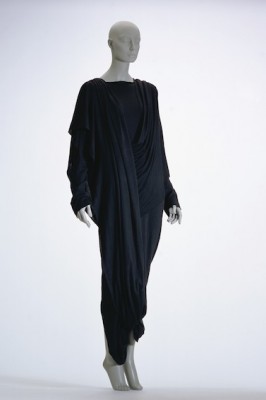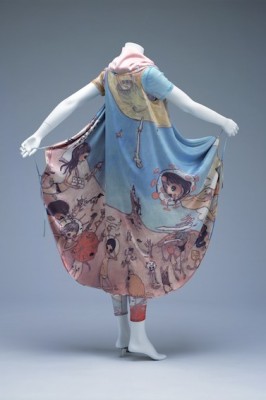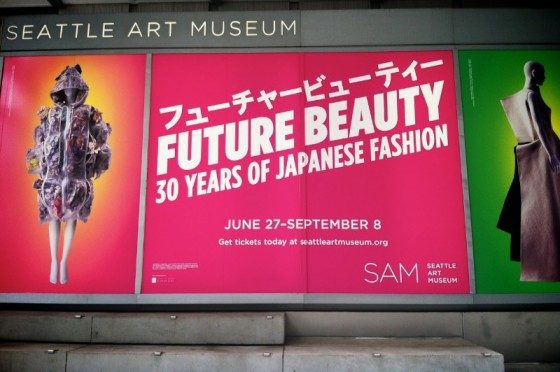The Seattle Art Museum’s new exhibit is a study in the cultural exchange between Japan and the US through fashion.
Remember doorknocker earrings, shoulder pads, and hair that was teased to no end?
Starting in the 1980s, Western influences like these had a snowball effect in the Japanese design industry. The West’s fitted and symmetrical styles sparked early designers like Yohji Yamamoto to create their own antithetical interpretations of these styles, drawing on the roots of Japanese clothing.

Some of their most influential work is on display at the Seattle Art Museum’s “Future Beauty: 30 Years of Japanese Fashion” exhibit, which showcases a timeline of the most celebrated Japanese designers through four thematic periods: “In Praise of Shadows,” “Flatness,” “Tradition and Innovation,” and “Cool Japan.”
Designers like Kenzo Takada and Issey Miyake, both featured in the exhibit, became well known in the 1970s. But it wasn’t until their first runway shows in Paris in the early Eighties, that their deconstructed, and almost rebellious, expressions intrigued the world.
Suddenly the fashion world was paying close attention to the development of designers like Yohji Yamamoto and Rei Kawakubo of the Comme des Garçons label.
“A lot of Japanese designers did not initially design for themselves, but did for a very international audience from the get go,” said Catharina Manchanda, SAM’s Jon and Mary Shirley Curator of Modern & Contemporary Art. “Subsequent decades in the 90s and 2000s, suddenly Japanese designers look back critically at Western designs and came back with innovative materials and structures.”
As I entered the exhibit at SAM last week, I was not surprised to see the gallery banner in bright neon yellow and hot pink, recalling the bright manga costumes of the Harajuku district of Tokyo.

Once inside the first section, “In Praise of Shadows,” I was shocked at how stark the contrast was. The designs range from thin and torn, to layered and billowy, all crafted in neutrals: white, ivory, or black fabrics.
“They are very carefully crafted. There’s a lot of contrast of different textures,” Manchanda said.
“Flatness” has a sense of volume and creating a sanctuary for empty space between the outfit and the body. Designer Issey Miyake explored the concept Ma, in which a garment envelops the body, as opposed to following the Western notion of fitted clothing. When these garments stand alone, their geometric outlines stand out.
In “Tradition and Innovation,” I recognized a few hints of Western costumes (even one seen on Lady Gaga a few years ago). Designer, Junya Watanabe even experimented with origami fold methods in her “Techno Couture” collection.
“These have amazing volume and cloud-like structures. They’re so aware of fashion history, that you can also see echoes of a 19th century Victorian dress or a French tailored jacket, but in a completely re-imagined version,” said Manchanda.

Once I entered the “Cool Japan” section, I started to reminisce about one of my favorite childhood shows “Sailor Moon.” References to youth pop culture from Japanese music groups to Hello Kitty and Astro Boy are screen-printed on basic jerseys.
The gallery in Cool Japan is all about street trends’ importance in social interaction.
“It reemphasizes your difference as opposed to a painting. It’s immediately public, you wear it and you take it outside, people will react to you and your friends immediately,” said Manchanda. “It’s fascinating and really unique to Japan,”
Japan’s three decade fashion explosion has unleashed a range of styles, from utilitarian, nonconformist, eclectic, gritty, and kawaii (Japanese for “cute”). Harajuku and the rest of Tokyo have been internationally known as the center for originality and self-expression. Don’t miss this extraordinary look at their world through designs.
Future Beauty: 30 Years of Japanese Fashion is at SAM until September 8th.



Great article!! I’d be curious to reexamine how Issey Miyake’s designs were manifested keeping the very specifically Japanese aesthetic principle of “ma” in mind. As I understand it, “ma” is the idea that there should be necessary emptiness within a space, keeping beauty and balance integrated within simplicity. Makes sense for billowy, unfitted garments! :)